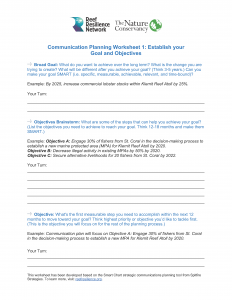Goal & Objectives
Step 1: Establish Your Goal & Objectives
The first step in the strategic planning process is to establish a strong, clear goal that defines your vision so you know where you want to go. Then you define the objectives – the steps for how you are going to get there. Identifying a clear goal and specific objectives is the most important part of a good strategy and will guide the rest of your efforts.
Watch a short presentation about establishing your goal and objectives:
Goal
To help articulate your goal, think big picture. Describe what the world will look like when you reach it. What will be different? Many of our conservation goals are long-term and can take 5, 10, 20 years or more to reach. For an effective and relevant communications strategy, think shorter term – focus on a goal that can be achieved in 3-5 years and objectives that can be achieved in the next 12-18 months.
Your goal should be specific. It should state exactly what needs to happen, where, and when, and with whom. A well crafted goal gives clear direction to the planning process and narrows the focus of your project in measurable ways, such as by geography, audience, and timeline. In other words, it’s SMART: specific, measurable, achievable, realistic, and time-bound. It is likely to take a few tries to write a SMART goal.
COMMUNICATION TIP
Regularly reminding yourself (and your team) of your goal can help prioritize your day-to-day activities to make sure the work you are doing is helping to move you closer to it.
Objectives
Once you have identified your goal, your next step is to divide it into “bite-size” objectives, the steps for how you reach your goal. Objectives should also be SMART and can be created based on the audience you’re trying to reach, action you’re trying to make happen, or the stages in your planning process.

Raising public awareness is not a SMART goal. The public is too large an audience, and awareness is usually only a step toward a behavior that will actually affect a goal. To get more specific, ask why do I want to raise awareness? What behavior do I want to change with what audience? Who do I need to sign a policy or bill into law? If you find yourself saying your goal is to raise awareness, we encourage you to dig deeper to get at the true action you’d like to achieve. What is the underlying reason more awareness is needed?
Test Your Understanding
Test your understanding of the information in this section by taking the quiz.
Your Turn (>30 minutes recommended)
Use the Goal and Objectives Worksheet to write down your goal and objectives.
Goal
Guiding questions for writing your goal:
- What is the issue or problem you are trying to solve? What are the most common or serious consequences of the issue?
- What is the change you are trying to achieve over the long-term and the short-term?
- What will be different in your place (community, organization, etc.) after you have achieved your goal?
- Is your goal SMART? (SMART = Specific, measurable, attainable (doable), realistic in terms of resources/organizational capacity, and time-bound)
Objectives
Objectives are the steps needed to achieve your goal. Objectives should be complementary to one another, but may not have to occur sequentially.
Once you have a list of objectives, you’ll need to prioritize them. Think critically about what will help you accomplish your goal and use that objective to work through the rest of this planning process. To be effective, a strategic communication plan should focus on one objective at a time, since each objective can have a different audience which could require different messages and tactics. This doesn’t mean you can’t tie all of this information together into one master plan. It just means that you need to walk through the strategic communication planning process for each objective.
Guiding questions for selecting and prioritizing objectives:
- Are any time-dependent?
- Do any have to happen in a specific order? Can any happen simultaneously?
- Which audiences are my objectives tied to?
- Which objective will have the most impact on key audiences?
- Which objective is most cost-effective?
- Which objective could cause the most negative impact if it’s not completed?
- Are some easier than others to execute?
This worksheet is based on Spitfire Strategies’ Smart Chart® strategic communications planning tool. The Smart Chart is a registered trademark of Spitfire Strategies. To learn more, visit: spitfirestrategies.com.

